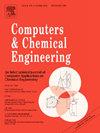Computer-aided mixture design using molecule superstructures
IF 3.9
2区 工程技术
Q2 COMPUTER SCIENCE, INTERDISCIPLINARY APPLICATIONS
引用次数: 0
Abstract
Computer-aided molecular and process design determines the best molecules together with their optimal process for a given objective function. The nonlinearity of typical thermodynamic models and the discrete nature of molecules lead to the challenge of solving a mixed-integer nonlinear programming problem. The optimization is even more demanding for a mixture design, in which two or more molecules and their composition are degrees of freedom. At the same time, the quality of the solution strongly depends on the accuracy of the thermodynamic model used to predict the thermophysical properties required to determine the process-based objective function and constraints. Today, most molecular design methods employ thermodynamic models based on group counts, resulting in a loss of structural information of the molecule during the optimization. The present work extends the integrated design of mixtures and processes in three areas: (1) Molecule superstructures represent chemical families by graphs that preserve the full adjacency matrix to unlock property prediction methods beyond first-order group-contribution methods. (2) Implicit automatic differentiation of process models determines Jacobians and Hessians needed for the optimization algorithm within machine precision. (3) A fine-tuned outer approximation algorithm efficiently calculates rankings of candidate mixtures for the non-convex integrated molecular and process design problem. In a case study, the design method is used to determine the optimal working fluid mixture for an Organic Rankine cycle.
基于分子超结构的计算机辅助混合设计
计算机辅助分子和工艺设计确定了给定目标函数的最佳分子及其最佳工艺。典型热力学模型的非线性和分子的离散性给混合整数非线性规划问题的求解带来了挑战。对于混合设计的优化要求更高,其中两个或多个分子及其组成是自由度。同时,溶液的质量在很大程度上取决于用于预测热物理性质的热力学模型的准确性,以确定基于过程的目标函数和约束。目前,大多数分子设计方法采用基于基团计数的热力学模型,导致优化过程中分子结构信息的丢失。目前的工作在三个方面扩展了混合物和过程的集成设计:(1)分子超结构通过保留完整邻接矩阵的图来表示化学族,以解锁超越一阶群贡献方法的性质预测方法。(2)过程模型的隐式自动微分决定了在机器精度范围内优化算法所需的雅可比矩阵和黑森矩阵。(3)一种微调外逼近算法有效地计算了非凸集成分子和工艺设计问题候选混合物的排名。在一个案例研究中,设计方法用于确定有机朗肯循环的最佳工作流体混合物。
本文章由计算机程序翻译,如有差异,请以英文原文为准。
求助全文
约1分钟内获得全文
求助全文
来源期刊

Computers & Chemical Engineering
工程技术-工程:化工
CiteScore
8.70
自引率
14.00%
发文量
374
审稿时长
70 days
期刊介绍:
Computers & Chemical Engineering is primarily a journal of record for new developments in the application of computing and systems technology to chemical engineering problems.
 求助内容:
求助内容: 应助结果提醒方式:
应助结果提醒方式:


